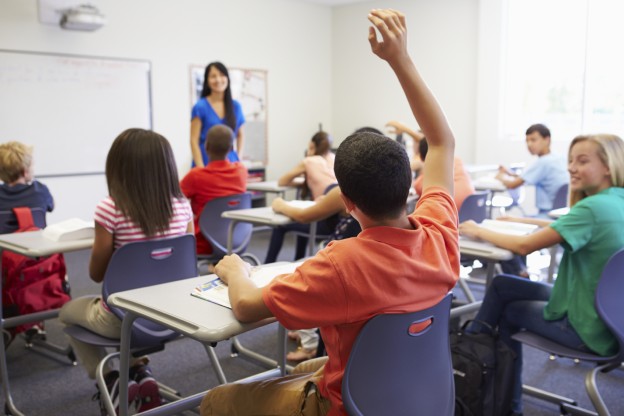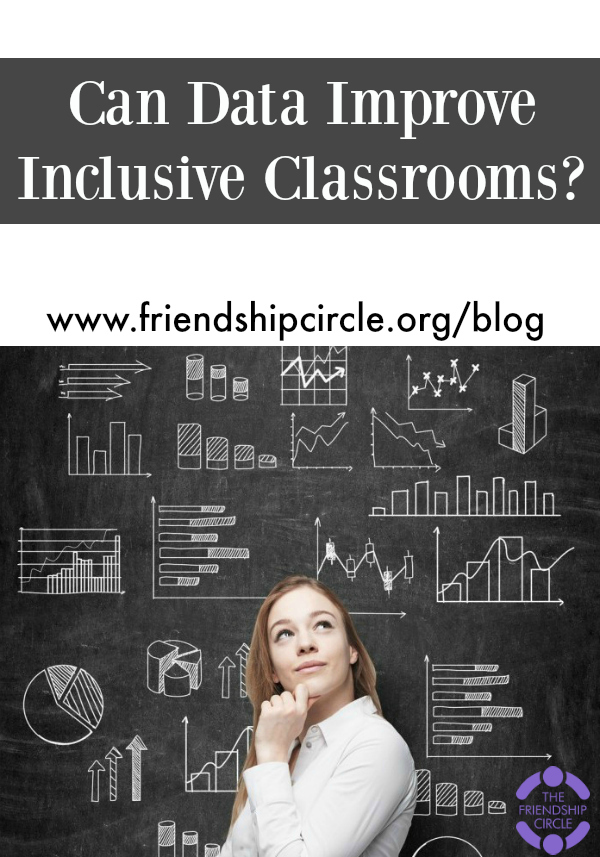
Opinion, Special Education  In many of today’s schools, inclusion is no longer the new buzzword. It is simply practice, but when I was teaching, it was still difficult for many of the more seasoned educators to understand. They were used to being disconnected from special needs students because that had been the traditional means of educating them.
As Susie Miles argued back in 2000, inclusion is about building relationships among all students and educators. When students are separated into different classrooms, relationships cannot be built. Yet bringing the two groups together doesn’t automatically fix everything. It can strain an educator’s most valuable resource: time.
A drain on resources of all kinds is one of the biggest concerns regarding inclusion, and for good reason. Relationship building takes time and effort, and it involves more than just the relationships among students and educators. It also means building relationships between teaching methods and learning outcomes. A little more technology can actually improve this rather than building even more barriers.
In many of today’s schools, inclusion is no longer the new buzzword. It is simply practice, but when I was teaching, it was still difficult for many of the more seasoned educators to understand. They were used to being disconnected from special needs students because that had been the traditional means of educating them.
As Susie Miles argued back in 2000, inclusion is about building relationships among all students and educators. When students are separated into different classrooms, relationships cannot be built. Yet bringing the two groups together doesn’t automatically fix everything. It can strain an educator’s most valuable resource: time.
A drain on resources of all kinds is one of the biggest concerns regarding inclusion, and for good reason. Relationship building takes time and effort, and it involves more than just the relationships among students and educators. It also means building relationships between teaching methods and learning outcomes. A little more technology can actually improve this rather than building even more barriers.
 Some educators might argue that more technology in classrooms will disconnect them from their students, the right combination could make inclusion a more all-encompassing effort. Apple recently rolled out a classroom manager for the iPad, allowing levels of both collaboration and data collection that was otherwise unheard of.
While data isn’t a great equalizer, it shows educators patterns and relationships. It can be used to pair students together in mentorship-style relationships for better learning outcomes. Analyzing students’ learning data, self-reported or otherwise, can also help an educator improve his or her own methods. Teachers and aids are often more concerned with analyzing data in order to manage students’ behavior, but not their own. Yet student performance data can, in many instances, mirror educator performance. Classroom data managers like Apple’s or even spreadsheets can help educators see the areas in which they need to change tactics or even lesson plans altogether.
When managing an inclusive classroom, educators aren’t just managing the kids with special needs. They’re managing, and in some cases, changing the behavior of all of the students in that classroom.
Training for educators is needed when they're working with data to influence the behaviors of multiple students. Degrees in Applied Behavior Analysis can help educators to pair data analysis with behavior analysis, and it can be applied to all students, especially if inclusion is new to them. Courses and certificates in Educational Technology are meant to help educators implement data and tech-driven instruction. There are even Master’s programs in Quantitative Methods in Education. This type of program is meant to teach educators advanced statistical research and evaluation techniques.
Some educators might argue that more technology in classrooms will disconnect them from their students, the right combination could make inclusion a more all-encompassing effort. Apple recently rolled out a classroom manager for the iPad, allowing levels of both collaboration and data collection that was otherwise unheard of.
While data isn’t a great equalizer, it shows educators patterns and relationships. It can be used to pair students together in mentorship-style relationships for better learning outcomes. Analyzing students’ learning data, self-reported or otherwise, can also help an educator improve his or her own methods. Teachers and aids are often more concerned with analyzing data in order to manage students’ behavior, but not their own. Yet student performance data can, in many instances, mirror educator performance. Classroom data managers like Apple’s or even spreadsheets can help educators see the areas in which they need to change tactics or even lesson plans altogether.
When managing an inclusive classroom, educators aren’t just managing the kids with special needs. They’re managing, and in some cases, changing the behavior of all of the students in that classroom.
Training for educators is needed when they're working with data to influence the behaviors of multiple students. Degrees in Applied Behavior Analysis can help educators to pair data analysis with behavior analysis, and it can be applied to all students, especially if inclusion is new to them. Courses and certificates in Educational Technology are meant to help educators implement data and tech-driven instruction. There are even Master’s programs in Quantitative Methods in Education. This type of program is meant to teach educators advanced statistical research and evaluation techniques.
 There is no blanket method for data analysis in inclusive classrooms. Every student, every educator, and every classroom is different. While it’s never wise to treat students as test subjects, educators in inclusive classrooms should experiment with different means of collection and different analyses in order to find the right fit, because doing so could be a benefit to everyone involved.
Like this post? Pin it for later on Pinterest here:
There is no blanket method for data analysis in inclusive classrooms. Every student, every educator, and every classroom is different. While it’s never wise to treat students as test subjects, educators in inclusive classrooms should experiment with different means of collection and different analyses in order to find the right fit, because doing so could be a benefit to everyone involved.
Like this post? Pin it for later on Pinterest here:

Can Data Improve Inclusive Classrooms?
Can Data Improve Inclusive Classrooms?
When I walked into my junior-senior high school classroom on the first day, there were about 50 students, the other freshman English teacher, and a special education aid. I was a brand new teacher, my colleague a seasoned, tenured veteran of the education system. That morning, it was the job of the trio of educators to divide up the 50 or so students into two preps of freshman English. It was taught at the same time, so why not just divide and conquer? There were a handful of students on 504s and IEPs, and just one available aid. Whose classroom would be inclusive, by the standards set more than 10 years ago? Whether it was lack of experience or strength of character, I volunteered to teach all of the special needs freshmen as best I could. Given my resources, I was rather successful, but if I had some of today’s resources, such as data collection and analytics, my inclusive classroom might have been much better.Yesterday’s Problems
 In many of today’s schools, inclusion is no longer the new buzzword. It is simply practice, but when I was teaching, it was still difficult for many of the more seasoned educators to understand. They were used to being disconnected from special needs students because that had been the traditional means of educating them.
As Susie Miles argued back in 2000, inclusion is about building relationships among all students and educators. When students are separated into different classrooms, relationships cannot be built. Yet bringing the two groups together doesn’t automatically fix everything. It can strain an educator’s most valuable resource: time.
A drain on resources of all kinds is one of the biggest concerns regarding inclusion, and for good reason. Relationship building takes time and effort, and it involves more than just the relationships among students and educators. It also means building relationships between teaching methods and learning outcomes. A little more technology can actually improve this rather than building even more barriers.
In many of today’s schools, inclusion is no longer the new buzzword. It is simply practice, but when I was teaching, it was still difficult for many of the more seasoned educators to understand. They were used to being disconnected from special needs students because that had been the traditional means of educating them.
As Susie Miles argued back in 2000, inclusion is about building relationships among all students and educators. When students are separated into different classrooms, relationships cannot be built. Yet bringing the two groups together doesn’t automatically fix everything. It can strain an educator’s most valuable resource: time.
A drain on resources of all kinds is one of the biggest concerns regarding inclusion, and for good reason. Relationship building takes time and effort, and it involves more than just the relationships among students and educators. It also means building relationships between teaching methods and learning outcomes. A little more technology can actually improve this rather than building even more barriers.
Today’s Solutions
 Some educators might argue that more technology in classrooms will disconnect them from their students, the right combination could make inclusion a more all-encompassing effort. Apple recently rolled out a classroom manager for the iPad, allowing levels of both collaboration and data collection that was otherwise unheard of.
While data isn’t a great equalizer, it shows educators patterns and relationships. It can be used to pair students together in mentorship-style relationships for better learning outcomes. Analyzing students’ learning data, self-reported or otherwise, can also help an educator improve his or her own methods. Teachers and aids are often more concerned with analyzing data in order to manage students’ behavior, but not their own. Yet student performance data can, in many instances, mirror educator performance. Classroom data managers like Apple’s or even spreadsheets can help educators see the areas in which they need to change tactics or even lesson plans altogether.
When managing an inclusive classroom, educators aren’t just managing the kids with special needs. They’re managing, and in some cases, changing the behavior of all of the students in that classroom.
Training for educators is needed when they're working with data to influence the behaviors of multiple students. Degrees in Applied Behavior Analysis can help educators to pair data analysis with behavior analysis, and it can be applied to all students, especially if inclusion is new to them. Courses and certificates in Educational Technology are meant to help educators implement data and tech-driven instruction. There are even Master’s programs in Quantitative Methods in Education. This type of program is meant to teach educators advanced statistical research and evaluation techniques.
Some educators might argue that more technology in classrooms will disconnect them from their students, the right combination could make inclusion a more all-encompassing effort. Apple recently rolled out a classroom manager for the iPad, allowing levels of both collaboration and data collection that was otherwise unheard of.
While data isn’t a great equalizer, it shows educators patterns and relationships. It can be used to pair students together in mentorship-style relationships for better learning outcomes. Analyzing students’ learning data, self-reported or otherwise, can also help an educator improve his or her own methods. Teachers and aids are often more concerned with analyzing data in order to manage students’ behavior, but not their own. Yet student performance data can, in many instances, mirror educator performance. Classroom data managers like Apple’s or even spreadsheets can help educators see the areas in which they need to change tactics or even lesson plans altogether.
When managing an inclusive classroom, educators aren’t just managing the kids with special needs. They’re managing, and in some cases, changing the behavior of all of the students in that classroom.
Training for educators is needed when they're working with data to influence the behaviors of multiple students. Degrees in Applied Behavior Analysis can help educators to pair data analysis with behavior analysis, and it can be applied to all students, especially if inclusion is new to them. Courses and certificates in Educational Technology are meant to help educators implement data and tech-driven instruction. There are even Master’s programs in Quantitative Methods in Education. This type of program is meant to teach educators advanced statistical research and evaluation techniques.
 There is no blanket method for data analysis in inclusive classrooms. Every student, every educator, and every classroom is different. While it’s never wise to treat students as test subjects, educators in inclusive classrooms should experiment with different means of collection and different analyses in order to find the right fit, because doing so could be a benefit to everyone involved.
Like this post? Pin it for later on Pinterest here:
There is no blanket method for data analysis in inclusive classrooms. Every student, every educator, and every classroom is different. While it’s never wise to treat students as test subjects, educators in inclusive classrooms should experiment with different means of collection and different analyses in order to find the right fit, because doing so could be a benefit to everyone involved.
Like this post? Pin it for later on Pinterest here:




